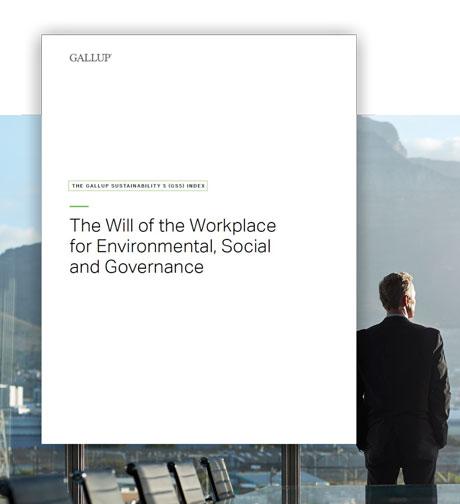Story Highlights
- Robust employee engagement metrics reliably predict performance
- Too many organizations settle for unscientific engagement measurements
- Only rigorous engagement methods will drive successful ESG initiatives
A recent Mattress Firm commercial begins, "We've got a problem, America. Junk sleep." The commercial lists the consequences of poor-quality sleep, from forgetting names to forgetting what your boss told you not to forget. At the end, Liev Schreiber intones, "Did you get out of the wrong side of the bed this morning, or the wrong bed altogether?"
The reality is that there are "junk" versions of internal corporate initiatives. Just as not all mattresses are created equally, not all employee engagement surveys are either. In fact, a lot of organizations are using a junk employee engagement survey -- and doing so will soon have serious consequences for many of them when it comes to new ESG regulations and new stakeholder expectations.
ESG refers to environmental, social and governance criteria for evaluating organizational success beyond profit. It challenges leaders to move away from a sole focus on short-term profit to long-term sustainability and the interest of all stakeholders.
Gallup has been closely following the ESG movement and its impact on workplaces around the world. Right now, leaders are deciding which metrics they should use to measure their organization's ESG progress. Employee engagement naturally falls into the "S," or social, part.
But at Gallup, we know that engagement is about a lot more than the "S." Engaged employees unlock an organization's potential across all initiatives. Engagement is the engine for organizational change because it identifies employees who are well-supported by their manager and motivated by the mission. When organizations face ESG-related challenges, engaged employees will be innovators and problem-solvers on the front line.
So, what's the problem here?
How to Spot Junk Employee Engagement Surveys
Most large organizations measure employee engagement. However, there are many ways to measure and report employee engagement, and they are not all equally discerning, insightful and actionable.
When organizations face ESG-related challenges, engaged employees will be innovators and problem solvers on the front line.
For example, Gallup's employee engagement metric, as measured by the validated Q12 survey, highlights that only 20% of the world's workers are engaged. (In the U.S., it's 32%.) Gallup's Exceptional Workplace Award winners, with remarkably high engagement compared with Gallup's database of millions of employees, average 70% engaged.
And yet it's easy to find organizations with serious culture issues, a poor customer experience reputation or poor business performance who say 80% of employees are engaged.
What's the difference?
Gallup is committed to helping organizations thrive by unleashing the potential of their people. This means that Gallup's engagement measurement is designed to be highly predictive of team and organizational performance -- a true gauge of human potential.
In contrast, many organizations survey employees and categorize them as engaged when, for all intents and purposes, they are merely content -- they are not emotionally invested, as most definitions of engagement qualify. For example, analysis of employee engagement surveys commonly combines partial agreement with full agreement. By Gallup's definition, this is closer to a measure of contentment than engagement.
There's no business reason to define engagement as contentment, except to inflate the percentage of engaged employees on a corporate dashboard. While 80% engagement looks good on paper, it obscures the strengths and weaknesses of the culture. When it comes to employee engagement, there's a big difference between trying to look good and painting a clear picture of what is really happening in an organization's culture.
While it's true that Gallup's engagement measure represents a higher bar, we are confident that our method more closely measures the kind of psychological engagement that makes a difference in employees' motivation and productivity.
So how can you tell if an employee engagement report is junk? Ask the following questions:
- How is the survey worded? Some surveys are unintentionally written in a way that encourages positive responses.
- Who was invited to do the survey? Some surveys are only a sample of employees, not a full census.
- How are scores calculated? As mentioned above, many reports combine responses to inflate scores, adding in individuals who are only moderately committed to their organization, to get a more favorable result -- even as many of them may be searching for jobs elsewhere.
- Can your organization demonstrate causality between engagement initiatives and increased engagement? Measuring causality is a true science, not speculation. Gallup works with clients to show leadership that actions and initiatives are working.
- Has your organization connected high or improving scores to positive business results? Gallup's latest Q12 meta-analysis of 112,312 teams found that highly engaged teams see higher productivity, quality, customer loyalty and profitability, compared with low-engagement teams. Gallup has 10 iterations of the meta-analysis and continually studies and validates the conclusions and that impact is highly generalizable across different types of organizations around the world.
How Leaders Should Publish ESG and Engagement Numbers
As we mentioned at the beginning, employee engagement is critical for successful ESG initiatives. Engaged employees will ultimately drive the real-world progress on these efforts. Therefore, knowing the true level of employee engagement at your organization will be an important part of your leaders' dashboard.
As ESG becomes more central to evaluating organizations, the way the "S" is reported will become increasingly important to investors, suppliers, communities, job seekers and customers. Stakeholders will be wary of metrics that seem too good to be true -- they will be seeking organizations that hold themselves to high standards. Professional investors will see right through junk metrics.
Gallup recommends the following for tracking and reporting on ESG:
- Drive change internally using an employee engagement survey validated to predict employee behaviors and future performance. To move the needle on culture and productivity, leaders need an in-depth, validated engagement measurement tool -- like Gallup's Q12, which provides wide visibility on what drives individual and team performance. Using employee contentment as the metric to gauge engagement, culture and future performance is like using revenue as the only metric on your financial statement -- it doesn't provide a complete picture of your financial health.
- When reporting for ESG purposes, use Gallup's publicly available People and Planet 5 survey. Gallup identified five workplace experiences and dimensions that are highly predictive of future behavior and business outcomes, specifically tied to ESG. We recommend that all organizations add the corresponding survey items to their current employee surveys to include the voice of the employee in your ESG reporting. You can view the technical details here.
- If you publish engagement scores, be transparent. When it comes to externally reporting employee engagement or other people metrics, there's one thing all organizations can do to strengthen their credibility: Publish the full range of responses across the scale. For example, if a survey uses a five-point scale, report the percentages for all five scale points. This allows organizations to avoid inflated reporting by combining numbers. It communicates transparency and the pursuit of excellence.
Leaders have a serious choice. Will you promote employee engagement numbers that look good on paper but don't represent the real culture of your organization? Or will you measure employee engagement in a way that represents reality and helps you reach your organization's ESG goals and aspirations?
Support ESG initiatives in your organization:
- Measure your employees' attitudes on ESG. Use five survey items that capture the employee voice and predict future outcomes.
- Download our ESG perspective paper. Read why ESG success requires a committed workforce.





